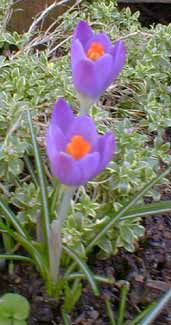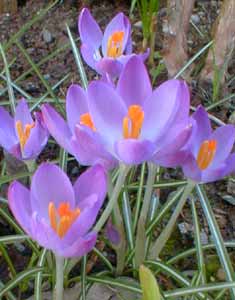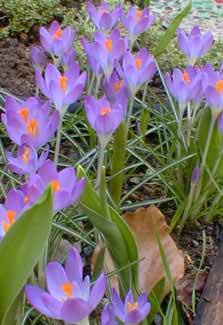
'Whitewell Purple' Tommies
"Little baby crocus
in his earthly bed
With the warm sun drawing him
popped out his tiny head.
Just as he was stirring
underneath the ground
Other little crocuses
were looking all around."
-anonymous
 We planted twenty-five or so Crocus tommasinianus 'Whitewell Purple' corms near the base of a female kiwi by a garden gate, over a more deeply planted group of 'China Pink' & 'Burgundy' Lily-flowering Tulips. This crocus blooms late February & March, whereas the tulips arise to take their place in May. The lily-flowering tulips may weaken after a few years, but the crocuses will remain a permanent feature by that garden gate.
We planted twenty-five or so Crocus tommasinianus 'Whitewell Purple' corms near the base of a female kiwi by a garden gate, over a more deeply planted group of 'China Pink' & 'Burgundy' Lily-flowering Tulips. This crocus blooms late February & March, whereas the tulips arise to take their place in May. The lily-flowering tulips may weaken after a few years, but the crocuses will remain a permanent feature by that garden gate.The first photo shows the very first 'Whitewell Purples' to open in our garden, just getting started in the third week of February (2003). The second & third photos, snapped on March 1st, show them in full sway.
'Whitewell Purple's' star-shaped flowers range from very reddish-hued lavender-purple to nearly "dayglow" in their richness of color, with silvery sheen to the outside of the petals, & yellow anthers in the pale throats. The pale throat is the white "well" that inspired this cloned botanical's name.
 They grow three to six inches tall, usually about four inches. In a sunny moist location these will self-seed & reproduce freely, becoming increasingly numerous over time.
They grow three to six inches tall, usually about four inches. In a sunny moist location these will self-seed & reproduce freely, becoming increasingly numerous over time.Its offspring do tend to grow true to the parent, as 'Whitewell Purple' is not really a cultivar, but a unique color strain of the wild crocus, discovered in Dalmatia. 'Whitewell' was selected & preserved by the Reverand Joseph Jacob (1859-1926), author of Hardy Bulbs for Amateurs (1924) & other bulb books. He also wrote several lovely fairy tale collections that I have had since I was very young, & which make good reading for children or adults. He has been likened to Charles Perrault or the Brothers Grimm.
It will cross-pollinate with other strains of tommies if any others are planted in the vicinity, in which case the seeds will not grow true to the parent after all, but will become intermediate varieties. Our other tommies are on a completely different side of the house, so perhaps our Whitewells will be able to seed true.
'Whitewell Purple' has tiny flowers, but individual corms can produce more than one blossom each, which makes a dramatic impression. It can be a good choice to plant right in lawns since, even though small, it blooms so early there is not much chance of grasses already being putting on height to hide it. Even if planted as we prefer in gardens rather than in lawns, it will inevitably self-seed into the nearby lawn as well.
The species tends to be very upright without the tendency of some crocuses to tip over in hard rain, overcast days, or for no reason but weakness of stems. On overcast days, tommy flowers remain closed & look like upright purple candles; Granny Artemis said they looked like soldiers at attention. If all species of crocuses stayed this upright rain or shine, I am sure more of my fellow Northwest gardeners would collect as many varieties as they could lay hands on. But they disappoint some people by only opening on the sunniest days, & there are years when most days throughout the crocus season are overcast.
I long ago decided that such pre-spring flowerings were too spectacular to forswear, & I just try to overlook how many varieties are tippy especially on overcast days when the blooms don't even open. But for anyone who cannot stand this, however, tommies are a good choice since they are sturdy no matter the weather, & three other varieties also leap to mind as remaining upright even when closed on cloudy days are the pale blue C. sieberi atticus 'Firefly,' the bright yellow C. koralkowii 'Kiss of Spring' & violet-blue Crocus etruscus 'Zwanenburg,' besides any variety of C. tommasinianus.
Other bulbs that produce short & very upright flowers in February, & that look perfect even on overcast are rainy days, include Scilla mischtschenkoana white with blue line in each petal, sundry kinds of Snowdrops & any variety of the dwarf Iris reticulata. Another bulb that is a February bloomer is Ipheion or Spring Starflower, which is beautiful rain or shine. On overcast days when the majority of crocuses stay closed, it is nice to have these other flowers about, which are not quite so dependent on the sun to show themselves to best effect.
The greater majority of crocus offerings are cultivars of C. chrysanthus, nearly all of which are only upright when fully opened, & which lean over when it is not a sunny day. C. ancyrensis is hard to get to stand up even on a sunny day & requires a groundcover to uphold it, which is also true of several of the autumn-blooming crocuses. Even though I've gotten used to this & plant as many kinds of crocuses as I can no matter what, I must admit that the tommies, because they stand so perfectly upright rain or shine, get many extra points of greatness.